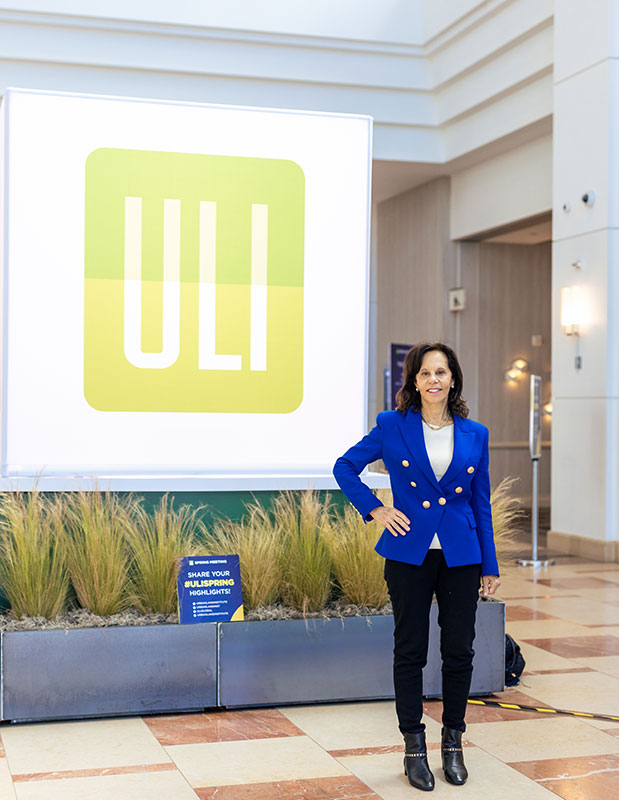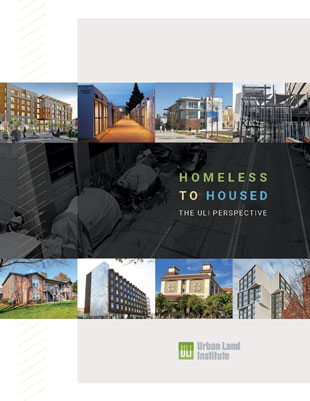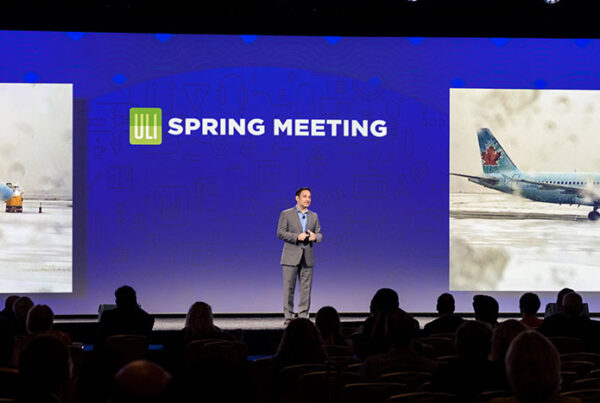
Leslie Himmel, founder and co-managing partner of Himmel + Meringoff Properties, at the 2022 ULI Spring Meeting in San Diego.
Despite ominous national headlines about New York City office, the vacancy rate is at 9.7 precent in the first quarter of 2022, a full 140 basis points above pre-pandemic levels, according to Moody’s. And, on the ground, New York City office landlords like Leslie Himmel, founder and co-managing partner of Himmel + Meringoff Properties, are doubling down on the city.
Himmel, with partner Stephen Meringoff, owns and manages a portfolio of roughly 2 million square feet and about 18 buildings in the desirable NoMad neighborhood and Upper Midtown, as well as medical buildings near New York University and warehouses in the city’s boroughs. Urban Land sat down with Himmel during ULI’s spring meeting in San Diego to get her perspective on the future of the city’s office market.
Where does the New York City office market stand right now?
Clearly, as everybody knows, COVID hit New York City quite hard. Since March 2020, we’ve been back in our office as have most real estate owners and developers since June 2020. What I think is most interesting about New York when you start reading the data on ‘Has New York City recovered?’ and ‘Is New York City being revitalized?’, and you dig into the statistics versus the news articles that are highlighting whatever is selling in that cycle, there have been a number of tech companies that have made big investments in New York City—Google is probably the most noteworthy; Facebook as well.
What are you seeing across your office portfolio?
Although things were quiet from March 2020, really through the end of 2020, in ’21, the first area in New York with tenants wanting to come back and do leases was our NoMad portfolio. NoMad is north of Madison Park. It’s a trendy cool area. The buildings there are a little bit older but have high ceilings.
Last year, we were fortunate enough to sign 700,000 square feet (65,032 sq m) of leases. Three of those were leases with 100,000 square feet (9,290 sq m) or more with credit tenants. And I laugh—but I don’t think it’s funny—because I’m tired of hearing people saying that New York, San Francisco, the big cities… it’s over. It’s not over.
And I think one has to look at the few 100 million square feet (9.29 million sq m) of buildings that we have and be in New York. So when you’re in New York, you’re seeing the vibrancy—the Broadway shows are packed, restaurants are active, the park is packed. The rhetoric for going back to office has been slow and yet the reality is that occupancies are now probably up to 43 percent. And we’re finding if you really work hard to show space and keep your head in the trenches, showing deals and not expressing ‘Woe is me and it’s so bad’ that you can make deals.
What are you seeing in terms of rents?
I’ll bet it is 20 percent lower in net effective rents. I think New York has a recovery, a revitalization, and a rebuilding. You see that from the enthusiasm of [Mayor] Eric Adams—he has gotten a lot of the companies back to their offices. We have companies like Coinbase who took new space in the last 18 months.
I’m very active with REBNY [Real Estate Board of New York] and yesterday I was at a Board of Governors meeting and we had Congressman Ritchie Torres speaking to us about how New York is going to recover. And I said, ‘Okay, please give us an example of one industry that we can look to—let’s not talk about Amazon not happening in Industry City, rezoning not happening. Give us one idea for an industry that New York City can get its arm around that needs to grow here.’ I thought his response was very smart. He said, ‘Well, that’s digital currencies and the whole cryptocurrency market.’
We need to change the amount of time it takes to get a license here because we should be the leader in Tech Meets Finance. And I can totally get my arms around that—I’m head of the Economic Development Committee for REBNY that I founded in 1992. All these years later, I’m still running that committee and we have Andrew Kimball [new President & CEO of New York City Economic Development Corporation] coming to our next meeting to brainstorm what industries that we can help grow in New York City. And I think from a standpoint of New York City’s recovery, we need to get more proactive versus reactive to industries that should be coming and really entertain them and give them business credits the same way Florida and Texas have been doing to the New York tenants and in California tenants.
Part of the return-to-office conversation has been that employees save money by not coming into the office. In response, New York’s Metropolitan Transportation Authority (MTA) is rolling out some temporary fare reduction programs. What are your thoughts about the new flex work environment?
Flex work from my vantage point is a good thing, not a bad thing. I’m a woman who worked every day of my life and who has two kids, and I wish I had had the opportunity to take a day off and work from home when my kids were infants. … Although I think as you look at interest rates going up and a recession around the corner, I’d like to see how people do working from home when jobs are being cut and not grown.
How do you compete when you’re working from home and you’re walking your dog, and you say you’re working, but you’re not totally working? … I think the work-from-home phenomena will be a little bit more of a hybrid and I don’t think anything’s wrong with that. But I think people who really want to do well in their industry and want to show up, will be showing up. An example is today: Here we sit at you ULI in San Diego. I just bumped into three people from New York that I haven’t seen in three years. I wouldn’t have bumped into them on a Zoom call. There is nothing like being amongst other people and reactivating connections and then getting a business deal out of that and sharing ideas.
How is the loss of amenities like restaurants impacting office?
If you’re in a building that’s forty stories, and it takes five minutes to get out, you want your amenities there. If you’re in a building that’s twelve stories with open windows, which is a lot of what we have, you’re really happy to get onto the street. There are still a number of health clubs that are open, spas that are reopening, and you walk down the street in New York and there’s tons of restaurants.
Many cities like Washington, D.C., are looking at converting office space in the downtown to multifamily. How will conversions figure into the New York City office market?
In New York, one of the things that we’re looking at on the Executive Committee and the Board of Governors for REBNY is a proposal to change the zoning below 61st Street so that you can take these office buildings and convert them to resi. Our residential occupancy rates and rental rates are higher than they were pre-COVID, and therefore, I think that you do need expansion or conversion of some of the office buildings, because there is too much office space available.
What should the public sector be doing to help revitalize New York City office?
The development of life science. I know we’re sitting here in San Diego—San Diego is one of the bigger clusters, as is Boston, and Boston’s cluster is about 40 million square feet (3,716,122 sq m) . We have a project at 525 West 57th Street, that we redeveloped into a life science property. And EDC [Economic Development Corporation] in New York has been giving tax credits but they are so complicated that it’s not enough to attract the life science people to convert.
Life Science in New York costs almost $400 a foot to build out the space, between the air conditioning, and the extra electricity, etcetera. New York City should look at the development of biotech and life science. It is a growth industry all over the country. And I think that their programs, although okay, should be expanded to give better tax credits and work aggressively to make New York City a cluster for life science.
In terms of what the city can do, I’d like to see them take industries like that and get more aggressive in fighting to have our share of the national growth because I think we need to be more aggressive with tax credits and incentives in order to be as large as Boston.
SIBLEY FLEMING is editor in chief of Urban Land.



